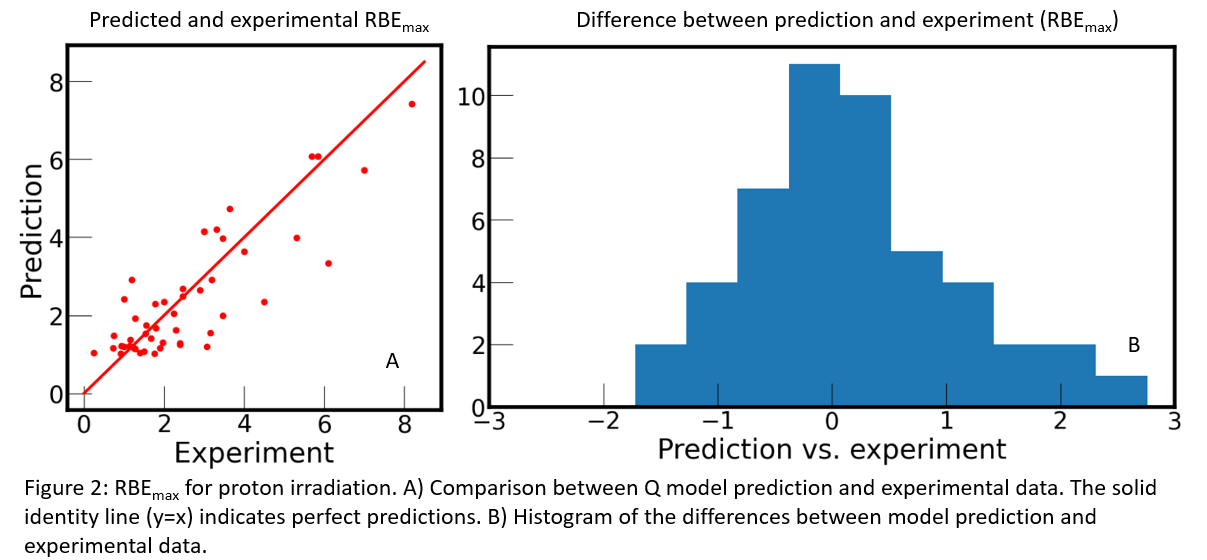A simple ion-type-independent in-vitro RBE description to improve proton RBE modelling
OC-0454
Abstract
A simple ion-type-independent in-vitro RBE description to improve proton RBE modelling
Authors: Liheng Tian1, Armin Lühr1
1Technical University Dortmund, Physics, Dortmund, Germany
Show Affiliations
Hide Affiliations
Purpose or Objective
Though a fixed value of 1.1 is used for the
relative biological effectiveness (RBE) in proton therapy (PT), more and more
clinical evidence of varying RBE has been reported. For carbon irradiation,
variable RBE has been considered for decades in clinical research and patient
treatment. This experience may be useful to boost RBE research in PT given an
ion-independent RBE description. In contrast to the linear energy transfer
(LET), on which multiple proton-specific models are based, the beam quality Q =
Z2/E (Z = ion charge, E = energy) was proposed and believed to lead
to a potential simple ion-independent RBE model. The particle irradiation data
ensemble (PIDE) provides experimental in-vitro RBE data from 115 publications
for various ions and, thus, the possibility to build and test potential
ion-type-independent RBE models. This work compares Q and LET using a Wedenberg-model-like
formula for a multi-ion situation.
Material and Methods
PIDE-recorded data fulfilling the following
criteria were considered in this work: 1) LET or Q range as in clinical PT, 2)
asynchronous cell cycle, 3) monoenergetic irradiation, 4) positive αx/βx value, 5) more than 5 data points for the same ion type.
The Wedenberg-model-like formulas for LET
and Q,
RBEmax
= 1 + kLET LET / (αx/βx)
and
RBEmax
= 1 + kQ Q / (αx/βx),
were considered (called LET and Q model in
the following, respectively) with RBEmax = αi/αx
being the ratio of ion and photon α. Linear regression was applied between RBEmax and either LET/(αx/βx) or Q/(αx/βx) for the selected data, both for each ion type individually and for
all data points (figure 1, A and B). The linear regressions for the individual
ions were compared. The dependence on ion type of the LET and Q model was
tested by conducting an ANOVA test for the residuals between the global fitting
(all data points) and the data points of each individual ion. Finally, the
capability to predict proton RBE was tested. Predictions of a Q model that was built
on a training dataset excluding all proton data were compared for the testing
dataset consisting of the experimental proton data.
Results
The slopes of the linear regression for individual
ions were clearly different for the LET model (max difference: 116%) while they
were similar for the Q model (18%, Fig 1C). Residuals for different ions were
significantly different for the LET model (p<0.00001) but not for the Q
model (p=0.63). The Q model trained without proton data was able to predict the
experimental data for protons (Fig 2). The mean and standard deviation of the
difference between prediction and test data were 0.153 and 0.923, respectively
(Fig 2B).

Conclusion
A simple Wedenberg-like Q model was
observed to be ion-independent in a clinical proton irradiation range for a
large in-vitro RBE dataset. This may support proton RBE modelling by adding
(pre)clinical RBE knowledge from carbon ion therapy to reduce the current biological
uncertainty in the treatment planning process in PT.